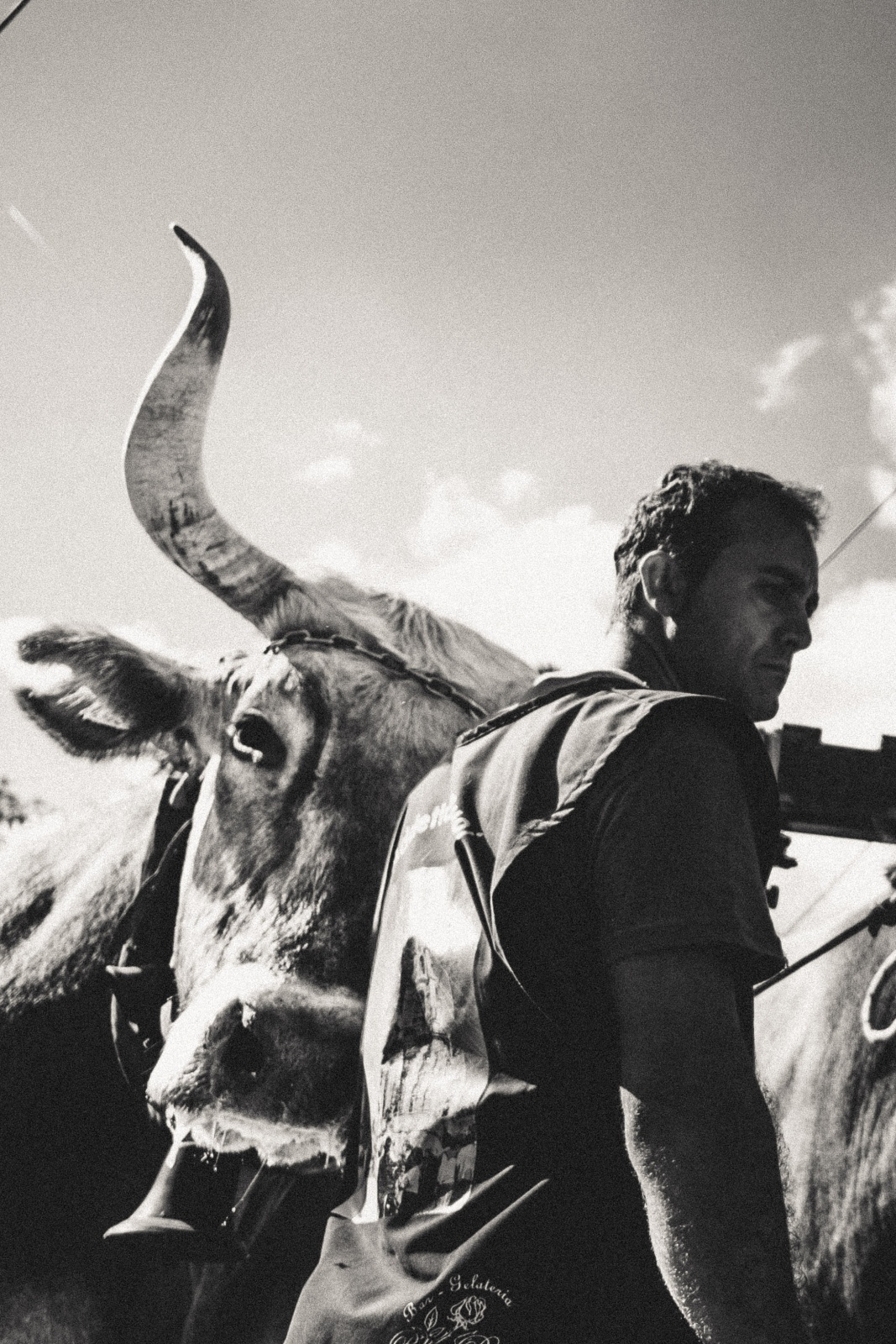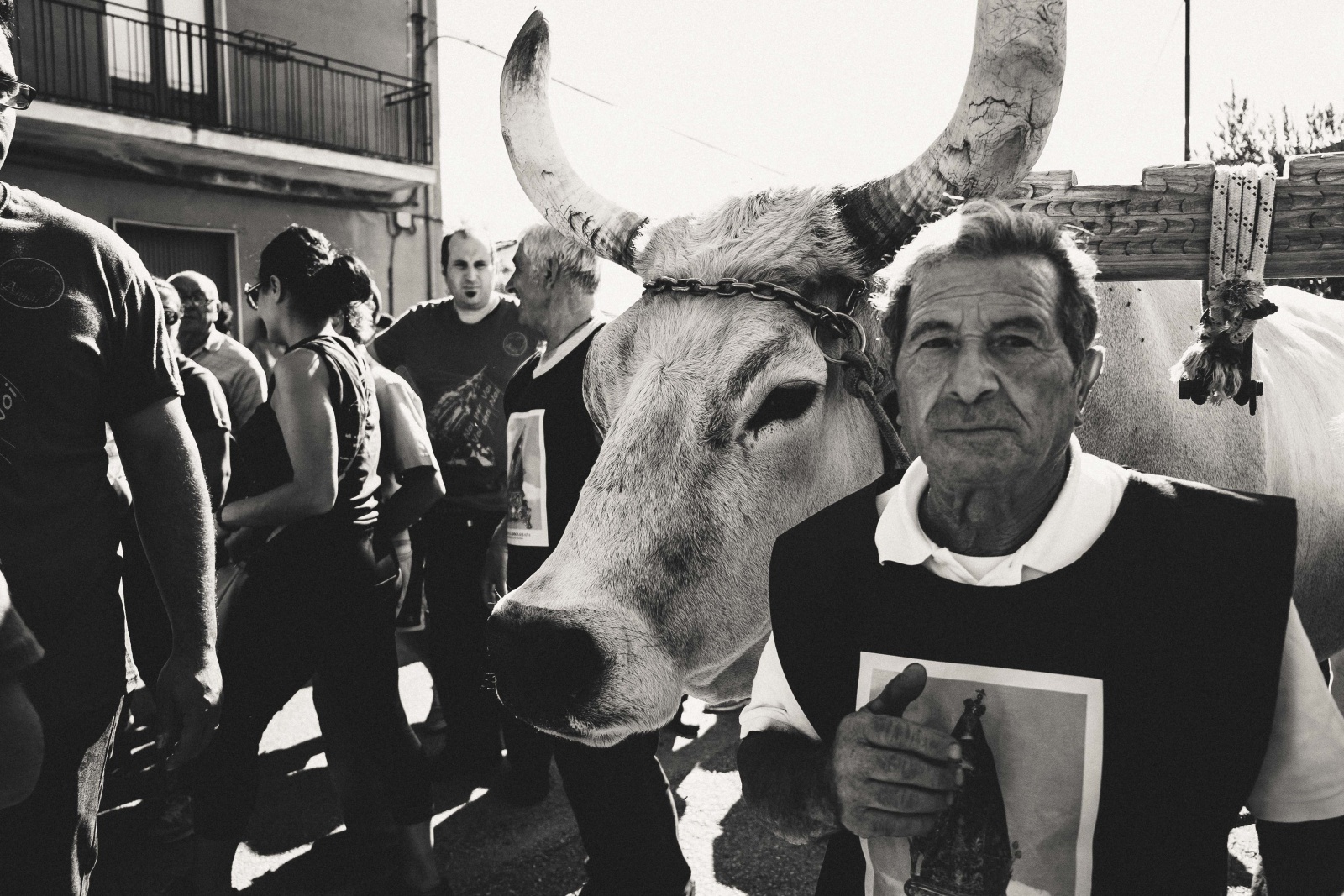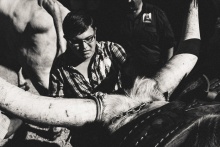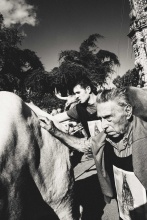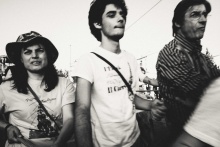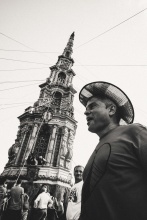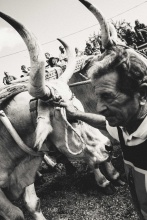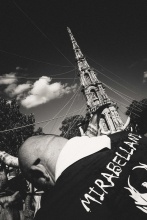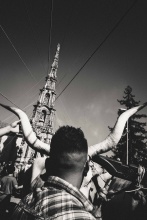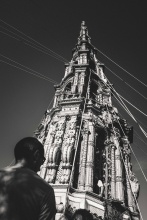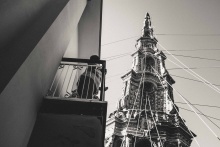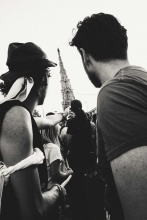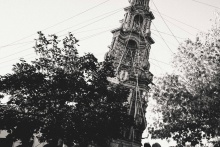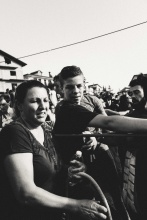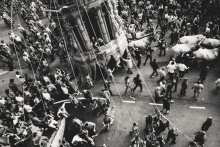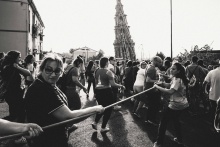






















la grande tirata
Ita
"La Grande Tirata", un reportage fotografico che documenta la tirata del carro di Mirabella, un evento che si radica nella storia e nelle tradizioni della comunità. Le immagini in bianco e nero selezionate per questa serie ritraggono con precisione i momenti più significativi e l'intensità dell'evento, mettendo in luce l'impegno dei volontari che partecipano attivamente alla manifestazione.
Ogni fotografia è un testimone silenzioso della manifestazione: il carro ornato, un monolite che si muove solennemente per le strade del paese, è il protagonista di una serie di scatti che ne mostrano la grandiosità e il dettaglio. I ritratti dei volontari, catturati mentre tirano le funi con dedizione e forza, rivelano la determinazione e lo spirito di comunità che anima la tradizione.
La scelta del bianco e nero è intenzionale, rimuovendo il colore per distillare l'evento ai suoi elementi più puros: luce, ombra, forma e emozione. Questa tecnica esalta la drammaticità e la gravità del momento, ponendo in risalto la relazione dinamica tra l'uomo e la sua eredità culturale.
"La Grande Tirata" è un invito a esplorare la complessità di questa celebrazione attraverso un medium che trascende il tempo: la fotografia. Ogni immagine racconta una storia di comunità, tradizione e lavoro di squadra, documentando non solo un evento, ma l'essenza stessa di Mirabella.
Invitiamo gli spettatori a immergersi in queste immagini, a riconoscere la bellezza e la potenza di queste tradizioni, e a riflettere sul loro valore intrinseco per la cultura e l'identità locale.
Eng
"The Great Haul," a photographic reportage that captures the essence of Mirabella's cart pulling event, rooted in the history and traditions of the community. The black and white images selected for this series accurately depict the most significant moments and the intensity of the event, highlighting the commitment of the volunteers who actively participate in the ceremony.
Each photograph silently witnesses the event: the adorned cart, a monolith that moves solemnly through the town's streets, is the subject of a series of shots showcasing its grandeur and detail. The portraits of volunteers, captured as they pull the ropes with dedication and strength, reveal the determination and community spirit that animate the tradition.
The choice of black and white is deliberate, stripping the event down to its purest elements: light, shadow, form, and emotion. This technique enhances the drama and gravity of the moment, highlighting the dynamic relationship between man and his cultural heritage.
"The Great Haul" is an invitation to explore the complexity of this celebration through a medium that transcends time: photography. Each image tells a story of community, tradition, and teamwork, documenting not just an event, but the very essence of Mirabella.
We invite viewers to delve into these images, to recognize the beauty and power of these traditions, and to reflect on their intrinsic value to local culture and identity.
"La Grande Tirata", un reportage fotografico che documenta la tirata del carro di Mirabella, un evento che si radica nella storia e nelle tradizioni della comunità. Le immagini in bianco e nero selezionate per questa serie ritraggono con precisione i momenti più significativi e l'intensità dell'evento, mettendo in luce l'impegno dei volontari che partecipano attivamente alla manifestazione.
Ogni fotografia è un testimone silenzioso della manifestazione: il carro ornato, un monolite che si muove solennemente per le strade del paese, è il protagonista di una serie di scatti che ne mostrano la grandiosità e il dettaglio. I ritratti dei volontari, catturati mentre tirano le funi con dedizione e forza, rivelano la determinazione e lo spirito di comunità che anima la tradizione.
La scelta del bianco e nero è intenzionale, rimuovendo il colore per distillare l'evento ai suoi elementi più puros: luce, ombra, forma e emozione. Questa tecnica esalta la drammaticità e la gravità del momento, ponendo in risalto la relazione dinamica tra l'uomo e la sua eredità culturale.
"La Grande Tirata" è un invito a esplorare la complessità di questa celebrazione attraverso un medium che trascende il tempo: la fotografia. Ogni immagine racconta una storia di comunità, tradizione e lavoro di squadra, documentando non solo un evento, ma l'essenza stessa di Mirabella.
Invitiamo gli spettatori a immergersi in queste immagini, a riconoscere la bellezza e la potenza di queste tradizioni, e a riflettere sul loro valore intrinseco per la cultura e l'identità locale.
Eng
"The Great Haul," a photographic reportage that captures the essence of Mirabella's cart pulling event, rooted in the history and traditions of the community. The black and white images selected for this series accurately depict the most significant moments and the intensity of the event, highlighting the commitment of the volunteers who actively participate in the ceremony.
Each photograph silently witnesses the event: the adorned cart, a monolith that moves solemnly through the town's streets, is the subject of a series of shots showcasing its grandeur and detail. The portraits of volunteers, captured as they pull the ropes with dedication and strength, reveal the determination and community spirit that animate the tradition.
The choice of black and white is deliberate, stripping the event down to its purest elements: light, shadow, form, and emotion. This technique enhances the drama and gravity of the moment, highlighting the dynamic relationship between man and his cultural heritage.
"The Great Haul" is an invitation to explore the complexity of this celebration through a medium that transcends time: photography. Each image tells a story of community, tradition, and teamwork, documenting not just an event, but the very essence of Mirabella.
We invite viewers to delve into these images, to recognize the beauty and power of these traditions, and to reflect on their intrinsic value to local culture and identity.
ITA - Informativa sui cookies • Questo sito internet utilizza la tecnologia dei cookies. Cliccando su 'Personalizza/Customize' accedi alla personalizzazione e alla informativa completa sul nostro utilizzo dei cookies. Cliccando su 'Rifiuta/Reject' acconsenti al solo utilizzo dei cookies tecnici. Cliccando su 'Accetta/Accept' acconsenti all'utilizzo dei cookies sia tecnici che di profilazione (se presenti).
ENG - Cookies policy • This website uses cookies technology. By clicking on 'Personalizza/Customize' you access the personalization and complete information on our use of cookies. By clicking on 'Rifiuta/Reject' you only consent to the use of technical cookies. By clicking on 'Accetta/Accept' you consent to the use of both technical cookies and profiling (if any).
Accetta
Accept Rifiuta
Reject Personalizza
Customize
ENG - Cookies policy • This website uses cookies technology. By clicking on 'Personalizza/Customize' you access the personalization and complete information on our use of cookies. By clicking on 'Rifiuta/Reject' you only consent to the use of technical cookies. By clicking on 'Accetta/Accept' you consent to the use of both technical cookies and profiling (if any).
Accetta
Accept Rifiuta
Reject Personalizza
Customize

